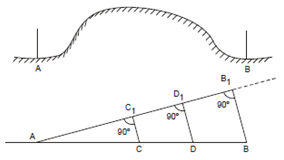Obstacles in Ranging:
Topography of land can create difficulties in ranging, i.e. ground undulations hindering clear visibility among main stations, e.g. existence of a hillock in the line of sight. These problems of obstacles in ranging can be solved by establishing mutually visible intermediate stations by reciprocal ranging as explained further.
If the two ends of a survey line A and B are not show from intermediate point on it, then reciprocal ranging cannot solve a problem. In such cases, a random line AB1 is drawn in any convenient direction but as close to point B as possible (Figure 13). The point B1 is selected such in which it is visible from B and BB1 is perpendicular to the random line. Measure BB1, select points C1 and D1 on the random line and erect perpendicular C1C and D1D on it. The value of C1C and D1D can be calculated as
C1C = (AC1/AB1) × BB1 and D1 D = (AD1/AB1) × BB1
After getting points C and D, join CD and prolong it.

Figure: Ranging when Ends not Inter-visible